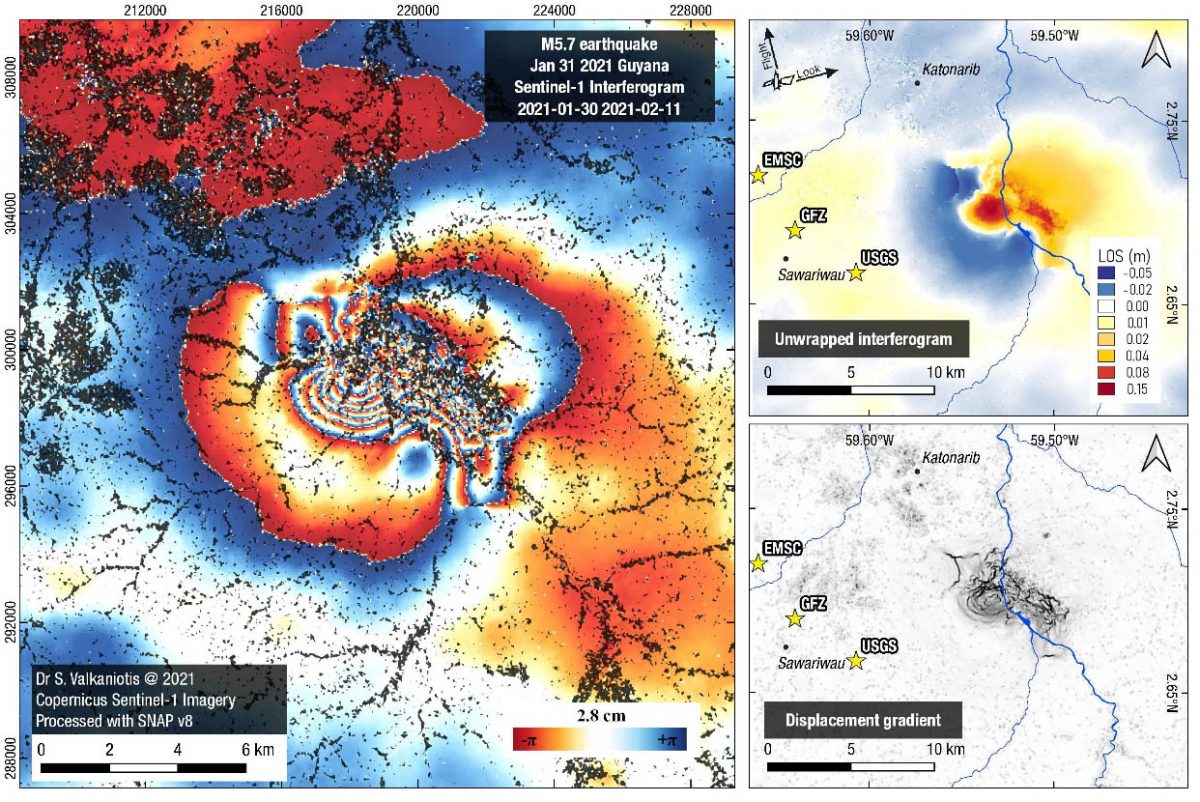 Taken into high orbit on a Soyuz rocket from Europe’s Spaceport in French Guiana, the watching satellite captured in astounding detail, the historic rupture from Guyana’s rare earthquake of magnitude 5.6 on January 31 last.
Taken into high orbit on a Soyuz rocket from Europe’s Spaceport in French Guiana, the watching satellite captured in astounding detail, the historic rupture from Guyana’s rare earthquake of magnitude 5.6 on January 31 last.
In vivid scarlet and blue, the combined images produced over 12 days by the Copernicus Sentinel-1 in interferograms, or colourful diagrams based on wave interference, were recently shared on Twitter, the popular microblogging service, by international specialist in earthquake geology and paleoseismology, Dr. Sotiris Valkaniotis.
Sentinel-1 is the short title for the European Radar Observatory, in the Global Monitoring for Environment and Security satellite family, designed and developed by the European Space Agency (ESA) and funded by the European Commission (EC)). The Copernicus missions made up of a pair of sophisticated space machines represent the European Union’s (EU) contribution to the Global Earth Observation System of Systems (GEOSS). They are named after the great Renaissance-era mathematician, astronomer and scientist, Nicolaus Copernicus who formulated a model that placed the Sun rather than Earth at the centre of the universe.
A technique known as Interferometric Synthetic Aperture Radar (InSAR) has likewise revolutionised our ability to study planetary events including earthquakes by allowing us to measure factors such as where, how far, and in what direction, they have caused the ground to move.
Since satellites observe massive stretches, they can quickly collect vast amounts of data, proving invaluable in cases like Guyana’s remote and sparsely-populated Rupununi area where there is no or very limited instrumentation in the wider monitored continental region.
Dr. Valkaniotis tweeted on February 12, “Surprising rupture from the M5.6 Jan 31 Guyana #earthquake. Copernicus #Sentinel1 interferogram. Possible complex surface trace of 6+ km with 20+ cm of displacement, consistent with a ~NW-SE strike…” musing, “That’s a first (?) for the South American craton.”
An ancient geological remnant of the young Earth’s continental lithosphere, the giant Amazonia craton that Guyana and sister states of South America rest on, termed the Guiana Shield acts as a usually stable, thick, protective barrier against big earthquakes. There is no tell-tale up-welling of hotter mantle as at mid-ocean ridges or in a continental rift.
Aged well over a billion years, and in some sections two billion years, the strong craton is the continent’s oldest nucleus or Precambrian geological formation, divided by the Amazon drain-age basin into two parts, the Guiana Shield in the north, and the Guaporé or Central Brazilian Shield in the south. The higher elevations on the shield are the Guiana High-lands, featuring the famous table-top mountains or tepuis, and magnificent waterfalls ranging from Kaieteur to Angel.
Dr Valkaniotis posted, the North West (NW)-South East (SE) strike “looks like a mainly N110-120 degrees reverse fault, in accordance with the focal mechanisms (FMs). Rupture pattern in detail is very complex – expected for very shallow intraplate thrusts. There are some interesting W-E (West-East) secondary ruptures at the tips,” he added.
A focal mechanism, or “beachball” is a graphic circular, 2-dimensional shaded symbol that indicates the type of slip and the orientation of the fault, surrounding the hypocenter, the location of the earthquake in the crust. If the rock mass above an inclined fault moves down, the fault is termed normal. If the rock moves up, it is termed reverse, while a thrust fault is a reverse fault with a dip of 45 degrees or less.
In the past, surface ruptures were rarely identified for M5 or smaller earthquakes, but this is changing with several seen, mainly due to InSAR images. In the past, without remote sensing such as InSAR, small surface breaks were not usually found, or were not associated directly with fault rupture, and these may have been interpreted as secondary effects of shaking. With InSAR, the absolute position of a rupture and other ground disturbances can be fixed to an accuracy of approximate 1 metre, as against standard earthquake location from distant seismograms which have an accuracy of only 1 km or more, another expert, Dr Anthony Lomax told me. Dr Lomax is a respected seismologist consultant, specialising in earthquake monitoring, location, and analysis, real-time/early-warning.
On February 1, Dr Lomax shared via Twitter, “very crisp seismograms at ~800km ENE in French Guiana, across the craton,” noting that the P and S waves arrived early – from the “cold,” rigid upper mantle, while the surface waves arrived late because of the thick crust. See https://twitter.com/CPPGeophysics/status/1355973882738429953/photo/1
When seismic waves pass through colder and rigid rock in a stable area such as the craton, they remain sharp and crisp, like hearing a sound across an open space, as opposed to that in a cave, with lots of echoes and overlapping noises, he explained.
There are very few M5 and larger earthquake in stable craton areas of the world each year. In a sense it was just chance that this one occurred in Guyana on Jan 31, but it is not at all unexpected to have such an earthquake somewhere in the world in a craton area.
If the Guyana earthquake which has generated discussion among seismic experts, is confirmed as the first identified surface rupture for the South American craton, it will join an exclusive group, since similar events have been recorded on other old cratons, such as in Australia and Africa.
Following the January 31 quake, the Rupununi was shaken by over 20 tremors including 4 quakes between 4.0 and 5.0 in magnitude, 10 quakes between 3.0 and 4.0M, and 5 quakes between 2.0 and 3.0M.
While we cannot predict earthquakes, just about any place on Earth can have one, the experts note. With the natural build-up of stress, even if very slowly, an earthquake will eventually occur, and without need for a human induced trigger, which is what happened in Guyana on Jan 31. But in most cases the aftershocks of a large earthquake for a given region diminish in size and thankfully, at least in this, we are no different.
ID welcomes the tweet by one earthquake expert from Oxford University, suggesting, “can we make a fan club for little weirdo earthquakes that do (or almost) rupture the surface?”

